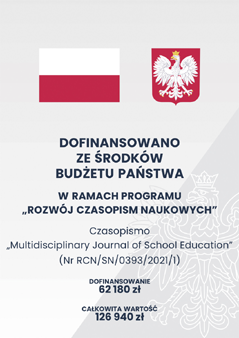Current research and teaching strategies for the writing, reading and literary education of the pupils with ADHD
Abstract
Attention-Deficit/Hyperactivity Disorder (ADHD) is one of the most common disorders of childhood and, as of 2006, 4.5 million children have been diagnosed at some time with ADHD. ADHD is described as having “many faces”, and as being “one of the most talked-about and controversial subjects in education”, causing “heated debates” (Bloom et Cohen, 2006). To be consistent with the existing literature, the term “ADHD” will be used in this paper and will represent the full spectrum of attention disorders.
There has been great controversy surrounding the acceptance of ADHD as a “real” disorder, which is likely related to the lack of a definitive diagnostic test and the perceived overuse of stimulant medication with children. The National Institutes of Mental Health (NIMH, 2009) states that ADHD is one of the most common childhood disorders and can continue through adolescence and into adulthood and involves difficulty staying focused and paying attention, difficulty controlling behaviour, hyperactivity (overactivity). The U.S. Department of Education (U.S. DOE, 2009) states that ADHD is a neurological condition that involves problems with inattention and hyperactivity – impulsivity that are developmentally inconsistent with the age of the child and is a function on developmental failure in the brain circuitry that monitors inhibition and self-control.
However, most professionals use the APA diagnostics manuals, though some use the ICD-10 Classification system of the World Health Organization, which uses the term hyperkinetic disorder. In the most current edition, the DSM-V (APA, 2013), ADHD is defined as a persistent pattern of inattention and/or hyperactivity – impulsivity that is more frequently displayed and more severe than is typically observed in individuals at a comparable level of development.
References
AMERICAN PSYCHIATRIC ASSOCIATION (APA): Diagnostic and Statistical Manual of Mental Disorders, 5th Edition (DSM-V), 2013
BARKLEY, R. A.: ADHD and the nature of self-control. New York: Guilfrod, 2005. ISBN 978-1-593-85231-3
BLOOM, B. et COHEN, R. A.: Summary of health statistics for US children: National health interview survey. In: National Centre for Health Statistics – Vital Health Statistics. Vol. 10, 2006, pp. 234-241
McINTOSH, K. et al.: Principles of sustainable prevention: Designing scale-up of school-wide positive behaviour support to promote durable systems. In: Psychology in the Schools. Vol. 47 (3), 2009, pp. 5-21
MRUG, S. et al.: Discriminating between children with ADHD and classmates using peer variables. In: Journal of Attention Disorders. Vol. 12 (3), 2009, pp. 372-580
MTA COOPERATIVE GROUP: A 14 month randomized clinical trial of treatment strategies for attention-deficit/hyperactivity disorder. In: Archives of General Psychiatry. Vol. 56, 1999, pp. 1073-1086
NATIONAL INSTITUTES OF MENTAL HEALTH (NIMH): Attention deficit hyperactivity disorder. 2009.
QUINN, P. O.: Treating adolescent girls and women with ADHD. In: Journal of Clinical Psychology. Vol. 61 (1), 2005, pp. 579-587
RICHARDS, T. L.: Driving anger and driving behaviour in adults with ADHD. In: Journal of Attention Disorders. Vol. 10 (3), 200, pp. 54-64
U.S. DEPARTMENT OF EDUCATION: Identifying and treating attention deficit hyperactivity disorder: A resource for home and school. 2009.
WEBB J.T., et al.: Misdiagnosis and Dual Diagnoses of Gifted Children and Adults. Tucson, AZ: Great Potential Press, 2005. ISBN 978-0-910-70764-0
WEYNADT, L. L. et al.: Assessment of teacher and school psychologist knowledge of attention-deficit/hyperactivity disorder. In: Psychology in the Schools. Vol. 46 (2), 2008, pp. 51-56
WYMBS, B. T. et al.: Rate and predictors of divorce among parents of youth with ADHD. In: Journal of Consulting in Clinical Psychology. Vol. 76 (3), 2008, pp. 735-744
Copyright (c) 2017 Jana Kožárová

This work is licensed under a Creative Commons Attribution-NoDerivatives 4.0 International License.
- The Author/Authors agree(s) to publish the article free of charge in Multidisciplinary Journal of School Education in English or Spanish. The Editorial Board reserves the right to shorten the texts and change the titles.
- As part of free publication mentioned in § 1, the Author/Authors agrees to make the full electronic version of their article available in the Internet.
- The Author/Authors agrees to index their article in databases at home and abroad, including abstracts and keywords as well as Author's/Authors’ affiliation in English and in other languages. The Author/Authors agrees to pass on the information mentioned above to the owners of these databases.
- The Author/Authors declares that their publication is original and does not include borrowings from other works which might cause Publisher's responsibility, does not infringe the rights of the third party and that their copyright on this publication is not limited. The Author/Authors will incur all the costs and will pay compensations which might result from the mendacity of the following statement.
- The Author/Authors declares to bear complete responsibility for the scientific reliability of the article submitted. The detailed contribution of all co-authors is defined.
- The Author/Authors declares to publish the text in the Multidisciplinary Journal of School Education under a Creative Commons Attribution-NoDerivatives 4.0 International License (CC BY-ND 4.0).
- For more than one author, please complete the Authorship Contributions and send it to the editorial office. Please indicate the specific contributions made by each author (list the authors’ initials, e.g., JKH). Please download, complete, scan and attach the file in the system during the submission process.
Authors Statement - Authorship Contributions






